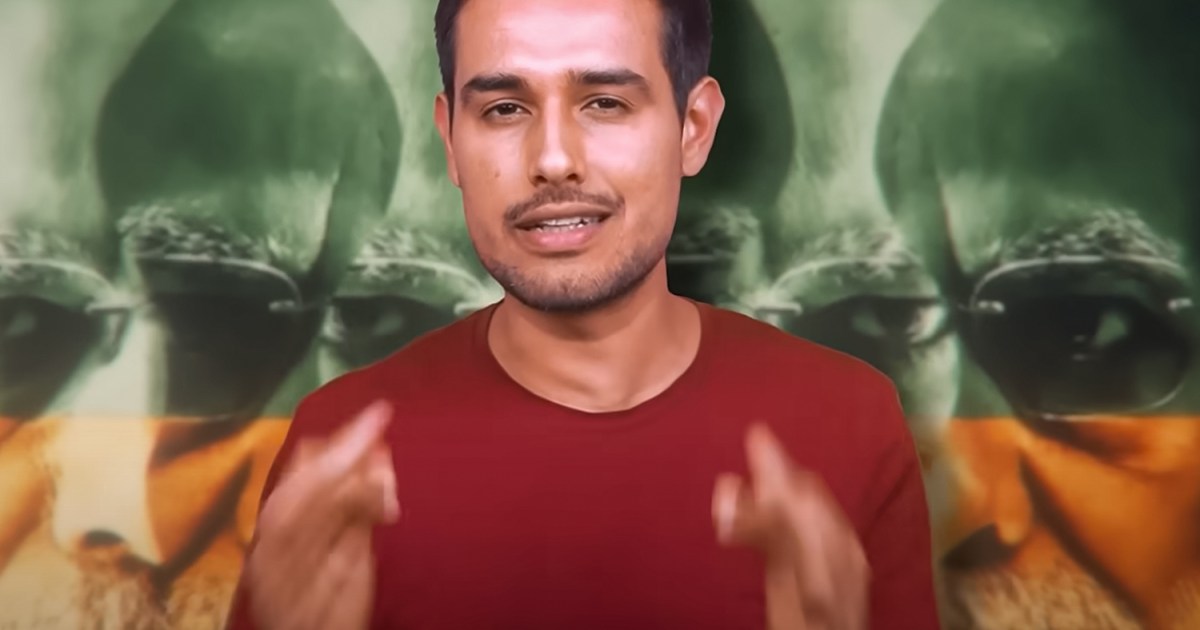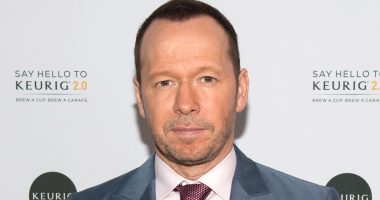
New Delhi, India — An ominous soundtrack serves as his backdrop as YouTuber Dhruv Rathee appears on the screen. His trademark collarless shirt – red on this occasion – and knowing half-smile are his only introduction before he launches straight into a troubling question: “Is India becoming a dictatorship?”
On the surface, the 29-year-old says, India appears to be a democracy: Citizens can choose from among a range of parties and decide whom to vote for. But the reality, he suggests, is more complex. He dives into allegations of corruption, misuse of supposedly independent institutions and subversion of democratic processes levelled by critics against Prime Minister Narendra Modi’s government.
It’s an intense 29-minute video, packed with Rathee’s monologue, slick animations and infographics, as he accuses the Modi government of systematically attacking the media and opposition. Issues like the year-long ethnic violence in the northeastern state of Manipur, where more than 200 people have been killed, have disappeared from the public discourse, Rathee says.
Like the music and animated caricatures he uses to drive home his arguments, the picture of India that Rathee paints is grim. It is a portrait far removed from the success story that Modi and his team insist they have turned the country into: A nation with growing global clout on the cusp of a $5 trillion economy.
As India’s giant national election, with 970 eligible voters, winds towards its conclusion, with the final phase of voting scheduled for June 1, and results on June 4, nowhere has that clash of narratives played out more sharply than on social media. On WhatsApp, for instance, Modi’s Hindu majoritarian Bharatiya Janata Party (BJP) reportedly runs 5 million channels: 400 million Indians are on the platform.
But if WhatsApp is big in India, YouTube is even bigger: With 460 million users, the country is the video platform’s biggest market. In one corner are a slew of YouTube channels, many with millions of viewers, that purport to be bringing viewers news but that often peddle disinformation and Islamophobia. In the other are Modi critics like Rathee, who too are accused by their opponents of selectively parsing data and facts to criticise the prime minister, while whitewashing embarrassing details about opposition leaders and parties.
At a time when studies show that more Indians trust news they get on YouTube and WhatsApp than what they source from mainstream news channels, Rathee has emerged as a formidable digital force. Polls suggest that Modi’s popularity remains high. But they also reveal that inflation and joblessness, issues of the kind that Rathee hammers on about in his shows, worry Indians the most.
And the YouTuber’s messaging reaches far more Indians on the platform than any opposition party or leader’s campaign slogans. Consider the numbers: On YouTube, Rathee has more than 20 million subscribers, nearly four times the BJP channel’s count. The Congress, the principal opposition party, has a little more than 5 million YouTube subscribers, while its biggest leader, Rahul Gandhi, has 6 million.
Rathee’s count, by comparison, is close to the man he often tries to take down in his videos: Modi, who has 23 million YouTube subscribers. In some cities, opposition parties have taken to screening Rathee’s videos in public, on mobile vans.
“We will bring a Tsunami that will destroy the whole IT Cell,” Rathee wrote on X last month, referring to the social media arm of the BJP that its critics accuse of driving political disinformation.
It was all very different a decade ago. Back then, to Rathee, Modi symbolised hope.
‘A very shocking moment’
When Narendra Modi first came into power, Rathee had just finished high school and moved to Germany to pursue a degree in mechanical engineering.
This is when he also started his YouTube channel. Rathee’s first video was a travel vlog shot on his iPhone 5s, which he says he edited for more than two months. It was the logical extension of his childhood passion for videography – in 2003, he says, he created a claymation video using a simple webcam.
In 2011, he, like millions of India’s youth, found themselves politically drawn to the first major nationwide movement the generation had seen – huge anticorruption protests against the then government of the Congress party that roiled the nation and paved the way for Modi’s national rise.
Like millions, Rathee also saw hope in Modi’s passionate advocacy against corruption in politics and black money in 2014. Rathee was a Modi supporter who welcomed his ascent to power.
But soon, the doubts started creeping in, and reached breaking point in 2015. The Aam Aadmi Party (AAP), nationally in the opposition but in power in Delhi, had introduced an anticorruption helpline. The Modi government at the centre battled with the AAP state government for control over the helpline, leaving Rathee disillusioned.
“That was a very shocking moment for me. I realised that he was not interested in removing corruption from India,” says Rathee, speaking of Modi, in an interview from an undisclosed location.
Rathee says his frustrations were compounded when he saw many mainstream TV channels demonstrate a deep bias in favour of Modi and the BJP.
It was against that backdrop that Rathee uploaded his first political commentary on YouTube, on September 16, 2016. The video, shot entirely on his phone, focused on the BJP’s IT cell and the alleged use of information – and misinformation – in shaping political narratives, through edited photographs, manipulated videos, fake quotes and paid posts to make a theme trend on social platforms. Rathee worked alone at the time and compared with what he puts out now, it was relatively crude in its production quality.
He has not looked back since then. Over the past eight years, he has published nearly 650 videos on his main YouTube channel – he still also maintains a separate channel with travel videos – many of them viewed by tens of millions of viewers. Some of the videos unpack history, such as what unfolded during World War II, or the heatwave searing through large parts of India. But for the most part, his focus is on politics.
“I like doing my educational videos and travel vlogs more but this is not the time to remain unaffected,” he tells Al Jazeera.
The secret sauce
Driving the success of his videos is a cocktail of ingredients, say Rathee and other YouTube influencers and political satirists who have tracked his work.
The heartland of the BJP’s support base is north India, where the party swept several states in 2014 and 2019, and has dominated many others. Hindi is the primary language in the region, with large rural belts. Rathee, who is himself from the agrarian state of Haryana, speaks simple, everyday Hindi in his videos.
That Rathee was a former Modi supporter himself gives him a cachet with others who have backed the prime minister at different times, but might now be wavering. And Rathee carefully uses the same nationalistic language that the BJP employs — a powerful communication strategy, says Akash Banerjee, a political satirist on YouTube, who also runs a channel called Deshbhakt (“patriot” in Hindi) that is often critical of the Modi government.
“He speaks to people in a language that appeals to them [Modi supporters and fence sitters] and also reaffirms the fact that the message is not ‘antinational’ – its anti-hate and anti-party worship,” Banerjee says. “The idea is to educate people that worshipping your country or religion is not equivalent to worshipping political leaders or parties.”
Rathee also accepts that his videos have evolved with time – and that he has learned in the process. Today, his videos have a self-assurance and confidence that he says have come through trial and error over many years. And though he is no journalist, he tries, he says, to bring journalistic rigour to his videos – which he insists are rooted in facts.
“I take criticism from well-meaning people seriously,” he says. “In some of my earlier videos, I mixed facts with opinions but that has changed now.”
Until 2020, he was doing everything – from research and scripting, to shooting and editing – on his own. “The disadvantage was that I also made a lot of mistakes in my videos,” he says.
Today, Rathee works with a team of researchers, scriptwriters and video editors. “We have made different systems to ensure factual accuracy. The overall production quality has also improved incredibly.”
Over the years, Rathee also developed a signature presentation style, shooting all his videos wearing a solid-coloured crewneck T-shirt. The videos all start with Rathee greeting his viewers with the words, “Namaskar doston” (Welcome friends).
Banerjee says Rathee’s ability to explain complex topics in simple words while keeping the facts intact and the production value high is what helps him grow his audience.
“In terms of reach, it’s quite unprecedented,” Banerjee says of Rathee’s success. “It signifies that there is definitely a disquiet. There are people who are willing to listen to facts. It’s a signal that the propaganda of the IT cells on social media is definitely failing.”
But Rathee himself believes the secret to his success lies, at least in part, in something simpler: His personal, emotional, almost boy-next-door approach in videos, which makes him more relatable to audiences and marks him out as different from more traditional, political hacks.
A lighter side
That approach is complemented by the other YouTube channel that Rathee runs: Dhruv Rathee Vlogs. It has 2.7 million subscribers, a fraction of the audience that comes to his political channel. But it offers insights into Rathee’s other obsession – travel.
The channel maps trips that Rathee and his German wife Juli take around the world, documenting their adventures: Meeting baby turtles at the Great Barrier Reef in Australia in one video, visiting a remote tribe in Mongolia in another; relaxing at a beach in the Seychelles and having a meal at one of the world’s highest hotels in Oman; visiting a London film set where a Harry Potter film was shot and diving into the world’s deepest pool in Dubai.
As with his political videos, Rathee speaks to his viewers in Hindi. Unlike his political channel though, Rathee’s approach here is light, relaxed, and meant to take his audience on a holiday, vicariously.
Sometimes, that lighter, less intense touch creeps into his political content. Like when the BJP released an election advertisement in which an actor depicting an Indian student stuck in Ukraine amid Russian shelling gratefully tells her father that Modi rescued her and her friends by “stopping the war”.
Rathee sarcastically responded by mimicking the actor. His “war rukwa di paw paw” (Modi ji stopped the war, Papa) turned the advertisement into a meme that went viral, turning the Modi government’s claim – which the country’s Ministry of Foreign Affairs itself has disputed – into a subject of ridicule.
For the most part, though, Rathee deals with darker themes. In 2023, after Modi promoted a controversial film, The Kerala Story, that claimed a conspiracy to convert non-Muslim women to Islam to send them to West Asia as fighters for the ISIL (ISIS) armed group, Rathee released a 23-minute video debunking the movie’s assertions. Following criticism, the filmmakers accepted that the movie was not entirely fact-based and that they had exaggerated the scale at which women from the southern state of Kerala had travelled to the Middle East to join ISIL (ISIS).
Rathee has his critics. In late May, Swati Maliwal, a member of parliament from the AAP, who has fallen out with the leadership of her party that governs in Delhi, alleged that Rathee had amplified a campaign against her that had resulted in her receiving death threats. Rathee has rejected those allegations.
Others have accused him of parroting opposition talking points selectively. And earlier in May, the Modi government’s minister for earth sciences and food processing, Kiren Rijiju, referenced an early video from Rathee that criticised corruption during the Congress government’s rule from 2004 to 2014.
Rathee hit back with a video, telling Rijiju that his earlier comments proved that he was no mouthpiece of any party, before then pointing out instances when the cabinet minister had apparently flip-flopped on his own comments.
Their sparring – a federal minister vs a YouTuber – continued on the social media platform X. “You’re a bright young man. Use your energy for nation’s growth,” Rijiju posted.
“No need to run down others to become more popular. Nothing wrong in being the spokesman of Congress & AAP but do spread positive vibes to create a better image of India.”
You’re a bright young man. Use your energy for nation’s growth. No need to run down others to become more popular. Nothing wrong in being the spokesman of Congress & AAP but do spread positive vibes to create a better image of India. https://t.co/j5kHiYNrc4
— Kiren Rijiju (मोदी का परिवार) (@KirenRijiju) May 23, 2024
Speaking to Al Jazeera at his bungalow in New Delhi, Rijiju insists that the accusations at the heart of many of Rathee’s videos– that the Modi government is dictatorial in its approach towards critics and the media – are bogus.
“There is so much freedom. These people abuse the prime minister all day,” Rijiju says. “The people can see through this and that’s why they [critics, including influencers like Rathee] will remain in an echo chamber.”
Yet, for many aspiring YouTube influencers –especially those eager to challenge the Modi government’s narrative – Rathee is a source of inspiration.
‘The time to speak up is now’
Rathee says he knows that the reach of his videos, though considerable, is still small compared with the BJP’s well-oiled narrative-shaping machinery. So in addition to his own videos, he tries to amplify the voices of others.
“You can only do so much individually. I will make as many videos as I can. There are other creators who’re doing good work. I am trying to collaborate with other creators and share them on my platforms,” he says.
The smaller content creators that he supports see a significant spike in their views. Political satirist Arpit Sharma has a day job as a chartered accountant and used to make anti-Modi sketches for fun. But he did not have professional editing and production resources.
What he did have was an influential follower on X: Rathee. “He [Rathee] reached out to me and got my video edited by his team and shared it on his own platform,” says Sharma.
That Sharma video has been watched by more than 14 million people. Rathee promoted another of Sharma’s videos again earlier this week, criticising the Modi government for failing on its promise to ensure the safety of women in India, highlighting several high-profile rape and sexual abuse cases.
Sharma says Rathee’s bootstrapped approach to building his own platform has been an inspiration to creators like him.
But taking on the Indian government publicly at a time when Indian politics is deeply divided comes with risks. Several influencers and online platforms with content critical of the governing BJP have been banned or censored in recent years.
In April, the Modi government asked YouTube to take down National Dastak, a YouTube channel run by a journalist-turned-politician. As farmers protested against the Modi government in states near Delhi earlier this year, the administration ordered X to block nearly 200 handles. The website of hate crime tracker HindutvaWatch was also blocked in India ahead of the elections. And India routinely ranks among the countries that send X the most requests to block accounts.
Seema Chisti, a veteran journalist and editor of the digital publication The Wire, says that the government’s use of IT laws to target critics sends a “message of censorship”.
“You kill the rooster to scare the monkeys. There is self-censorship and a chilling effect it brings with it,” she says. Media advocacy groups have also warned about the new law that the Modi government has said it wants to bill, which they say could give the administration more control over broadcasters. “The attempt is to create a China-type firewall. I have been around as a reporter for around 33 years, but I haven’t really seen this sort of censorship,” says Chisti.
Rathee says he has been targeted by disinformation campaigns linking him and his wife Juli to Pakistan, India’s arch-enemy. He regularly receives death threats while his wife has received rape threats online.
He insists he is not scared, but the YouTuber is careful not to disclose either his location or that of his family still in India.
At the end of the day, Rathee says, he has no option but to carry on doing what he does. He says he knows his channel could get banned in India. But the price of staying silent is bigger, he insists.
“The time to speak up is now, otherwise it would be too late,” Rathee warns in a video interview with Deshbhakt’s Banerjee.
“We are not a dictatorship yet but we are on the path to becoming one.”
Read More: World News | Entertainment News | Celeb News
Aljazera








